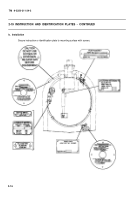TM-9-2350-311-34-2 - Page 71 of 552
TM 9--2350--311--34--2
Change 3
2--9
13
Inspection will be inclusive of all assemblies and parts described herein. All bolts, screws, nuts, and
mounting and locking devices will be securely installed.
NOTE
Make sure that identification markings on major assemblies correspond to those entered in
Weapon Record Data book.
14
See that Weapon Record Data entries (DA Form 2408--4) (which provide a continuous record of firings and
other related service life data pertaining to weapon tubes) are complete and up-to-date as required by the
provisions of DA PAM 750--8.
15
Ensure all components and assemblies of the mount operate smoothly and perform satisfactorily.
16
Painting procedures will conform to those outlined in TM 43--0139 and changes.
17
Lubrication must be complete and in accordance with lubrication charts in TM 9--2350--311--10 and
TM 9--2350--311--20--2.
18
Cleaning will be performed in accordance with TM 9--2350--311--10 and TM 9--2350--311--20--2.
19
On completion of inspection, all unpainted surfaces will be coated lightly with a film of CLP (item 11, Appx B)
per TM 9--2350--311--10 and TM 9--2350--311--20--2.
20
All accessories and spare parts will be inspected for serviceability and completeness.
21
Minor indentations, scratches, or rust pits will not be cause for rejection or replacement of parts unless the
damage is of sufficient magnitude to cause unsatisfactory functioning of component or assembly.
Section III. GENERAL MAINTENANCE PROCEDURES
2--8
DISASSEMBLY AND ASSEMBLY PROCEDURES
NOTE
Gears, bearings, sleeves, and other components mounted on shaft may require use of arbor
press (item 13, Appx F) for disassembly and assembly.
Complete disassembly of a component is not always necessary to make a required repair or replacement. Good judgment
should be used to keep disassembly operations to a minimum.
In disassembling a unit, first follow basic inspection procedures, then remove as many major components and
subassemblies as possible. These components may then be reduced, as necessary, into individual parts.
During disassembly, tag critical parts such as bearings and electrical harnesses and leads, to facilitate reassembly. This is
especially important for electrical equipment if circuit number tags are illegible or missing.
Back to Top




















